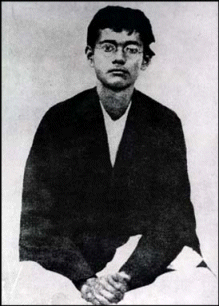skip to main |
skip to sidebar
 Mohandas Karamchand Gandhi was born in Porbander, a coastal town in present-day Gujarat, Western India, on October 2, 1869. His father, Karamchand Gandhi, who belonged to the Hindu Modh community, was the diwan (Prime Minister) of the eponymous Porbander state, a small princely state in the Kathiawar Agency of British India. His mother, Putlibai, who came from the Hindu Pranami Vaishnava community, was Karamchand's fourth wife, the first three wives having apparently died in childbirth. Growing up with a devout mother and the Jain traditions of the region, the young Mohandas absorbed early the influences that would play an important role in his adult life; these included compassion to sentient beings, vegetarianism, fasting for self-purification, and mutual tolerance between individuals of different creeds.
In May 1883, the 13-year old Mohandas was married to 14-year old Kasturbai Makhanji (her first name was usually shortened to "Kasturba," and affectionately to "Ba") in an arranged child marriage, as was the custom in the region. However, as was also the custom of the region, the adolescent bride was to spend much time at her parents' house, and away from her husband. In 1885, when Gandhi was 15, the couple's first child was born, but survived only a few days; earlier that year, Gandhi's father, Karamchand Gandhi, had passed away. Mohandas and Kasturbai were to have four more children, all sons: Harilal, born in 1888; Manilal, born in 1892; Ramdas, born in 1897; and Devdas, born in 1900. At both his middle school in Porbandar and high school in Rajkot, Gandhi remained an average student academically. He passed the matriculation exam for Samaldas College at Bhavnagar, Gujarat, with some difficulty, and while there, was unhappy, in part, because his family wanted him to become a barrister.
Mohandas Karamchand Gandhi was born in Porbander, a coastal town in present-day Gujarat, Western India, on October 2, 1869. His father, Karamchand Gandhi, who belonged to the Hindu Modh community, was the diwan (Prime Minister) of the eponymous Porbander state, a small princely state in the Kathiawar Agency of British India. His mother, Putlibai, who came from the Hindu Pranami Vaishnava community, was Karamchand's fourth wife, the first three wives having apparently died in childbirth. Growing up with a devout mother and the Jain traditions of the region, the young Mohandas absorbed early the influences that would play an important role in his adult life; these included compassion to sentient beings, vegetarianism, fasting for self-purification, and mutual tolerance between individuals of different creeds.
In May 1883, the 13-year old Mohandas was married to 14-year old Kasturbai Makhanji (her first name was usually shortened to "Kasturba," and affectionately to "Ba") in an arranged child marriage, as was the custom in the region. However, as was also the custom of the region, the adolescent bride was to spend much time at her parents' house, and away from her husband. In 1885, when Gandhi was 15, the couple's first child was born, but survived only a few days; earlier that year, Gandhi's father, Karamchand Gandhi, had passed away. Mohandas and Kasturbai were to have four more children, all sons: Harilal, born in 1888; Manilal, born in 1892; Ramdas, born in 1897; and Devdas, born in 1900. At both his middle school in Porbandar and high school in Rajkot, Gandhi remained an average student academically. He passed the matriculation exam for Samaldas College at Bhavnagar, Gujarat, with some difficulty, and while there, was unhappy, in part, because his family wanted him to become a barrister.


In 1930, following the success of earlier marches, 78 volunteers marched to Dandi sea beach demonstrating a model of satyagraha which was to be followed all over India by more than 5 million people. The aim was to break the law by taking natural salt deposits to manufacture and to sell salt in protest over the salt tax which enabled the sale and import of salt from England. The tax, which hit the poor masses worst, was taken up by Gandhi as a symbol of the oppression of the British Empire over India. In a symbolic act, Gandhi took a lump of salt up and said , 'With this, I am shaking the foundation of the British Empire.'
Later in life, Gandhi took up the cause of the ‘untouchables’ who he renamed ‘Harijan’ or children of God, embarking on a nine month tour to abolish untouchability 1933-4 and became involved in promoting education through basic crafts, moving away from political life in the mid 1930s to concentrate on more social issues. After a life time as the Mahatma (Great Soul) he was assassinated on his way to prayer on January 30th 1948.

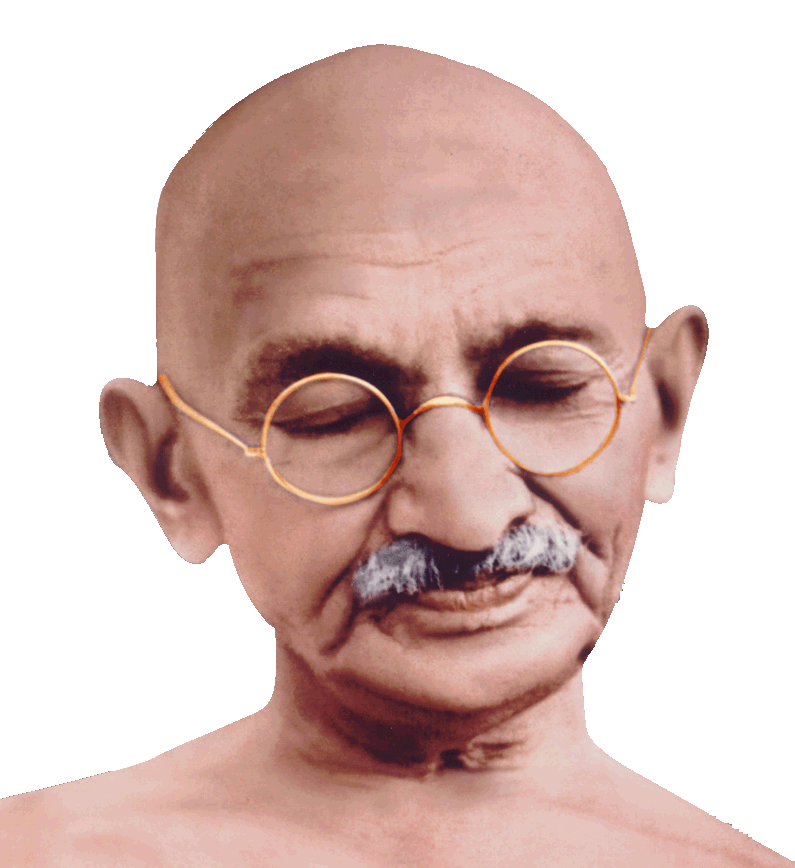
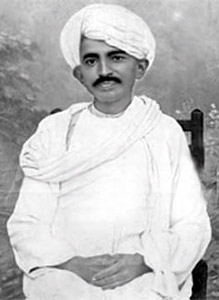
 Pandit Nehru was born on 14th November, 1889 to Motilal Nehru, an eminent lawyer and Swaroop Rani. He completed his post-graduation from Cambridge. On his return to India, he was not interested in the legal profession, but was attracted towards the freedom movement in India and joined the Congress. He was compassionate towards the poor and downtrodden and excelled himself as a statesman. He was good orator, very outspoken in his views.
Pandit Nehru was a blend of Eastern values and Western thinking. He favored technological progress. He was a writer as well as poet and wrote the “Discovery of India” and “Glimpses of World History” .
Pandit Nehru was born on 14th November, 1889 to Motilal Nehru, an eminent lawyer and Swaroop Rani. He completed his post-graduation from Cambridge. On his return to India, he was not interested in the legal profession, but was attracted towards the freedom movement in India and joined the Congress. He was compassionate towards the poor and downtrodden and excelled himself as a statesman. He was good orator, very outspoken in his views.
Pandit Nehru was a blend of Eastern values and Western thinking. He favored technological progress. He was a writer as well as poet and wrote the “Discovery of India” and “Glimpses of World History” .
 Jawaharlal Nehru received education in some of the finest schools and universities of the world. He did his schooling from Harrow and completed his Law degree from Trinity College, Cambridge. The seven years he spent in England widened his horizons and he acquired a rational and skeptical outlook and sampled Fabian socialism and Irish nationalism, which added to his own patriotic dedication.
Jawaharlal Nehru returned to India in 1912 and started legal practice. He married Kamala Nehru in 1916. Jawahar Lal Nehru joined Home Rule League in 1917. His real initiation into politics came two years later when he came in contact with Mahatma Gandhi in 1919. At that time Mahatma Gandhi had launched a campaign against Rowlatt Act. Nehru was instantly attracted to Gandhi’s commitment for active but peaceful, civil disobedience. Gandhi himself saw promise and India’s future in the young Jawaharlal Nehru.
Jawaharlal Nehru received education in some of the finest schools and universities of the world. He did his schooling from Harrow and completed his Law degree from Trinity College, Cambridge. The seven years he spent in England widened his horizons and he acquired a rational and skeptical outlook and sampled Fabian socialism and Irish nationalism, which added to his own patriotic dedication.
Jawaharlal Nehru returned to India in 1912 and started legal practice. He married Kamala Nehru in 1916. Jawahar Lal Nehru joined Home Rule League in 1917. His real initiation into politics came two years later when he came in contact with Mahatma Gandhi in 1919. At that time Mahatma Gandhi had launched a campaign against Rowlatt Act. Nehru was instantly attracted to Gandhi’s commitment for active but peaceful, civil disobedience. Gandhi himself saw promise and India’s future in the young Jawaharlal Nehru.
 The Jallianwala Bagh massacre, Gandhiji's satyagraha movement and other events swept him completely into the national struggle. It did not take him long long to emerge as a great national leader. When he was only 40 he was elected to preside over the momentous Lahore session of the Congress in 1929- it was here that the resolution on Puna Swaraj was adopted. He often came into conflict with his father who was for Dominion Status. The two loved each other deeply in spite of their differences and it is likely the son influenced the father.
He had differences with Gandhiji also but these did not come in the way of his faith in the leadership of the Mahatma. Jawaharial so endeared himself to the latter that he wrote: "He is pure as crystal, he is truthful beyond suspicion. He is a knight sans peur, sans reproche. The nation is safe in his hands." Gandhiji nominated him as his political heir.
Jawaharlal spent many years of his political career in gaol. His life of sacrifice earned him the affection of his countrymen. Indeed next to the Mahatma he was our most popular leader. India and its people became his major concern and during his tour of the country he was moved by the vast crowds that came to see him. He was a man of many interests, fond of nature, particularly the mountains. He was some what impetuous and in him there was a wonderful combination of the man of action and the man of thought. He wrote sensitively and his several books brought hirn international fame-"An Autobiography", "Glimpses of World History" and "Discovery of India" are among the more notable of his publications.
It is difficult to say which of Panditji's two periods is more memorable- the one before freedom or the one after it. During both he played a crucial role. His prime ministership of free India was a blessing to the nation. It was mainly because of him that the country did not go to pieces during the first years of upheaval. (We do not of course forget that there were others like Sardar Patel who did much to preserve the country's integrity. Nehru often differed from the Sardar and once or twice Gandhiji brought them together.)
Jawaharial Nehru was Prime Minister for seventeen years. During this period he worked to take India to the modem era and at the same time earned for it a place in the world. He himself came to be counted among the great leaders of his time, a bitter opponent of colonialism who was looked upon for inspiration by the Afro-Asian world. He will be remembered not only for the dams and laboratories he built and for laying the foundation of heavy industry. He will have his place in history as a man who had a great vision of India and the world and endeavoured to fulfil it by his action.
Pandit Jawaharlal Nehru, the first Prime Minister of Independent India, was loved by the people both as a man and a leader. He stands foremost among the builders of modern India, giving it a direction towards socialism in a secular, democratic setting. Writer and historian, Nehru through his books influenced the thinking of generations of Indians and made them thirsty for a free, democratic, socialist, secular India with science and technology as its driving force. He was largely responsible with initiating planned economic development
The Jallianwala Bagh massacre, Gandhiji's satyagraha movement and other events swept him completely into the national struggle. It did not take him long long to emerge as a great national leader. When he was only 40 he was elected to preside over the momentous Lahore session of the Congress in 1929- it was here that the resolution on Puna Swaraj was adopted. He often came into conflict with his father who was for Dominion Status. The two loved each other deeply in spite of their differences and it is likely the son influenced the father.
He had differences with Gandhiji also but these did not come in the way of his faith in the leadership of the Mahatma. Jawaharial so endeared himself to the latter that he wrote: "He is pure as crystal, he is truthful beyond suspicion. He is a knight sans peur, sans reproche. The nation is safe in his hands." Gandhiji nominated him as his political heir.
Jawaharlal spent many years of his political career in gaol. His life of sacrifice earned him the affection of his countrymen. Indeed next to the Mahatma he was our most popular leader. India and its people became his major concern and during his tour of the country he was moved by the vast crowds that came to see him. He was a man of many interests, fond of nature, particularly the mountains. He was some what impetuous and in him there was a wonderful combination of the man of action and the man of thought. He wrote sensitively and his several books brought hirn international fame-"An Autobiography", "Glimpses of World History" and "Discovery of India" are among the more notable of his publications.
It is difficult to say which of Panditji's two periods is more memorable- the one before freedom or the one after it. During both he played a crucial role. His prime ministership of free India was a blessing to the nation. It was mainly because of him that the country did not go to pieces during the first years of upheaval. (We do not of course forget that there were others like Sardar Patel who did much to preserve the country's integrity. Nehru often differed from the Sardar and once or twice Gandhiji brought them together.)
Jawaharial Nehru was Prime Minister for seventeen years. During this period he worked to take India to the modem era and at the same time earned for it a place in the world. He himself came to be counted among the great leaders of his time, a bitter opponent of colonialism who was looked upon for inspiration by the Afro-Asian world. He will be remembered not only for the dams and laboratories he built and for laying the foundation of heavy industry. He will have his place in history as a man who had a great vision of India and the world and endeavoured to fulfil it by his action.
Pandit Jawaharlal Nehru, the first Prime Minister of Independent India, was loved by the people both as a man and a leader. He stands foremost among the builders of modern India, giving it a direction towards socialism in a secular, democratic setting. Writer and historian, Nehru through his books influenced the thinking of generations of Indians and made them thirsty for a free, democratic, socialist, secular India with science and technology as its driving force. He was largely responsible with initiating planned economic development
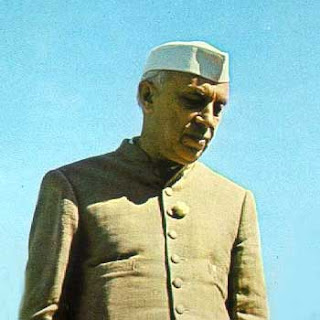

 Sardar Vallabhbhai Patel the iron-man of India was born on 31st October, 1875, in a small village in Nadiad. His father Jhaberbhai Patel was a simple farmer and mother Laad Bai was a simple lady. From his childhood itself, Patel was a very hard-working individual. He used to help his father in farming and studied in a school at N. K. High school, Petlad. He passed his high-school examination in 1896. Throughout school he was a very wise and intelligent student. Inspite of poor financial conditions his father decided to send him to college but Vallabhbhai refused. Around three years he stayed at home, worked hard and prepared for the District Leader's examination, hence passing with very good percentage.
Sardar Vallabhbhai Patel the iron-man of India was born on 31st October, 1875, in a small village in Nadiad. His father Jhaberbhai Patel was a simple farmer and mother Laad Bai was a simple lady. From his childhood itself, Patel was a very hard-working individual. He used to help his father in farming and studied in a school at N. K. High school, Petlad. He passed his high-school examination in 1896. Throughout school he was a very wise and intelligent student. Inspite of poor financial conditions his father decided to send him to college but Vallabhbhai refused. Around three years he stayed at home, worked hard and prepared for the District Leader's examination, hence passing with very good percentage.
 Vallabhbhai Patel was a major political and social leader of India and its struggle for independence, and is credited for achieving the political integration of independent India. In India and across the world, he is known as Sardar Vallabhbhai Patel, where Sardar stands for Chief in many languages of India. Patel organized the peasants of Kheda, Borsad, and Bardoli in Gujarat in non-violent civil disobedience against the oppressive policies imposed by the British Raj - becoming one of the most influential leaders in Gujarat. He rose to the leadership of the Indian National Congress and at the forefront of rebellions and political events - organizing the party for elections in 1934 and 1937, and leading Indians into the Quit India movement. He was imprisoned by the British government on numerous occasions, especially from 1931 to 1934, and from 1942 to 1945. Becoming the first Home Minister and Deputy Prime Minister of India, Patel organized relief and rehabilitation efforts in the riot-struck Punjab and Delhi, and led efforts to restore security. Patel took charge of the task to forge a united India from a plethora of semi-independent princely states, colonial provinces and possessions. Patel employed an iron fist in a velvet glove diplomacy - frank political negotiations backed with the option (and the use) of military action to weld a nation that could emancipate its people without the prospect of divisions or civil conflict. His leadership obtained the peaceful and swift integration of all 565 princely states into the Republic of India. Patel's initiatives spread democracy extensively across India, and re-organized the states to help transform India into a modern federal republic. His admirers call him the Iron Man of India. He is also remembered as the "patron saint" of India's civil servants for his defence of them against political attack, and for being one of the earliest and key defenders of property rights and free enterprise in independent India.
Vallabhbhai Patel was a major political and social leader of India and its struggle for independence, and is credited for achieving the political integration of independent India. In India and across the world, he is known as Sardar Vallabhbhai Patel, where Sardar stands for Chief in many languages of India. Patel organized the peasants of Kheda, Borsad, and Bardoli in Gujarat in non-violent civil disobedience against the oppressive policies imposed by the British Raj - becoming one of the most influential leaders in Gujarat. He rose to the leadership of the Indian National Congress and at the forefront of rebellions and political events - organizing the party for elections in 1934 and 1937, and leading Indians into the Quit India movement. He was imprisoned by the British government on numerous occasions, especially from 1931 to 1934, and from 1942 to 1945. Becoming the first Home Minister and Deputy Prime Minister of India, Patel organized relief and rehabilitation efforts in the riot-struck Punjab and Delhi, and led efforts to restore security. Patel took charge of the task to forge a united India from a plethora of semi-independent princely states, colonial provinces and possessions. Patel employed an iron fist in a velvet glove diplomacy - frank political negotiations backed with the option (and the use) of military action to weld a nation that could emancipate its people without the prospect of divisions or civil conflict. His leadership obtained the peaceful and swift integration of all 565 princely states into the Republic of India. Patel's initiatives spread democracy extensively across India, and re-organized the states to help transform India into a modern federal republic. His admirers call him the Iron Man of India. He is also remembered as the "patron saint" of India's civil servants for his defence of them against political attack, and for being one of the earliest and key defenders of property rights and free enterprise in independent India.
On 29 March 1949, a plane carrying Patel and the Maharaja of Patiala lost radio contact, and Patel's life was feared for all over the nation. The plane had made an emergency landing in the desert of Rajasthan upon an engine failure, and Patel and all passengers were safe, and traced by nearby villagers. When Patel returned to Delhi, members of Parliament and thousands of Congressmen gave him a raucous welcome. In Parliament, MPs gave a thunderous ovation to Patel - stopping proceedings for half an hour. Till his last few days, he was constantly at work in Delhi. Patel's health worsened after 2 November 1950, and he was flown to Bombay to recuperate. After suffering a massive heart attack - his second - he died in Bombay on December 15th, 1950. In an unprecedented gesture, more than 1,500 officers of India's civil and police services congregated at Patel's residence in Delhi on the day after his death to mourn him - they pledged "complete loyalty and unremmitting zeal" in India's service. His cremation in Sonapur, Bombay, was attended by large crowds, Nehru, Rajagopalachari, President Prasad and many Congressmen and freedom fighters.

Sardar started his legal practice in Godhra and at the age of 36, he went to England for further studies. He returned to India in 1913 and started his practice in Ahemdabad. He soon became a successful lawyer but his dream and career soon flourished.
Inspired by the work and philosophy of Mahatma Gandhi, he decided to join the freedom struggle. His first attempt was to fight for the cause of peasants in Kheda, Bardoli and other parts of Gujarat who were asked to pay heavy taxes to the British Government. Patel, under the leadership of Gandhi Ji, launched non-violent Civil Disobedience Movement against the payment of raised taxes. The Government tried to suppress the revolt but unfortunately could not do so. Finally, the taxes were suspended and thereafter everyone addressed Patel as Sardar. Further, he was also involved in Salt Satyagraha in Nagpur and Quit India Movement in 1942. He also opposed alcoholism, untouchability, caste discrimination and violence. In 1931, he was elected as the President of Indian National Congress.
After independence he was appointed as the first Home Minister and Deputy Prime Minister of India. He had served the country during the tenure but Gandhi Ji’s death gave him a major heart attack and he died on December 15, 1950.
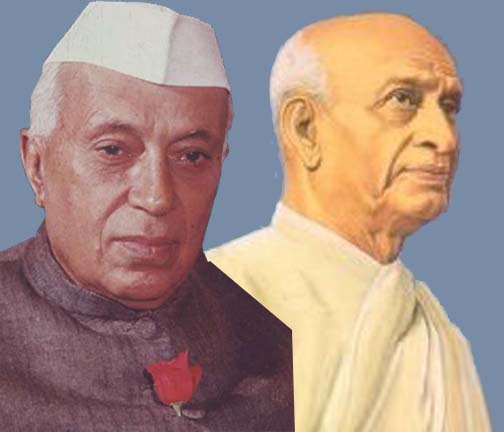
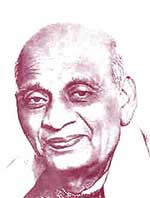

Netaji Subhash Chandra Bose, a prominent leader of the Indian independence movement, was born on January 23 1897 in Cuttack, Orissa. Netaji was elected the president of Indian National Congress, but due to ideological conflicts with Mahatma Gandhi, he established a separate political party, the All India Forward Bloc and continued to call for the full and immediate independence of India from British rule. He was imprisoned by the British authorities 11 times. Later, he formed the Azad Hind Government in exile, regrouped and led the Indian National Army. Netaji is presumed to have died on 18 August 1945 in a plane crash over Taiwan. However, there are few contradictory evidences regarding his death in the accident.

Nethaji Subhash Chandra Bose was born on January 23, 1897 at Cuttack, in Orissa. He was the sixth son of Janakinath and Prabhavati Bose.
Subhash was an excellent student and after school joined the Presidency College, Calcutta, where he studied philosophy, a subject he was interest in.
As a young boy Subhash felt neglected among his 8 siblings. At his English school he suffered under the discrimination faced by Indians which made him even sadder.
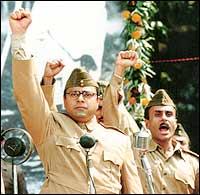

Subhash Chandra Bose was a very intelligent and sincere student but never had much interest in sports. He passed his B.A. in Philosophy from the Presidency College in Calcutta. He was strongly influenced by Swami Vivekananda's teachings and was known for his patriotic zeal as a student. He also adored Vivekananda as his spiritual Guru.
Known as Netaji (leader), Mr. Bose was a fierce and popular leader in the political scene in pre-independence India . He was the president of the Indian National Congress in 1937 and 1939, and founded a nationalist force called the Indian National Army. He was acclaimed as a semigod, akin to the many mythological heroes like Rama or Krishna, and continues as a legend in Indian mind.
Subhas Chandra was born on January 23rd 1897 in Cuttack (in present day Orissa) as the ninth child among fourteen, of Janakinath Bose, an advocate, and Prabhavatidevi, a pious and God-fearing lady. A brilliant student, he topped the matriculation examination of Calcutta province and passed his B.A. in Philosophy from the Presidency College in Calcutta. He was strongly influenced by Swami Vivekananda's teachings and was known for his patriotic zeal as a student. His parents' wishes kept him away from the Indian freedom struggle and led him into studies for the Indian Civil Service in England. Although he finished those examinations also at the top of his class (4th), he could not complete his aprecentship and returned to India, being deeply disturbed by the Jallianwalla Bagh massacre. He came under the influence of Mahatma Gandhi and joined the Indian National Congress (a.k.a. Congress). Gandhiji directed him to work with Deshbandhu Chittaranjan Das, the Bengali leader whom Bose acknowledged as his political guru.
 Bose wanted to free India from the Eastern front. He had taken care that Japanese interference was not present from any angle. Army leadership, administration and communications were managed only by Indians. Subhash Brigade, Azad Brigade and Gandhi Brigade were formed. INA marched through Burma and occupied Coxtown on the Indian Border. A touching scene ensued when the solders entered their 'free' motherland. Some lay down and kissed, some placed pieces of mother earth on their heads, others wept. They were now inside of India and were determined to drive out the British! Delhi Chalo (Let's march to Delhi) was the war cry.
The bombing of Hiroshima and Nagasaki changed the history of mankind. Japan had to surrender. Bose was in Singapore at that time and decided to go to Tokyo for his next course of action. Unfortunately, the plane he boarded crashed near Taipei and he died in the hospital of severe burns. He was just 48.
The Indian people were so much enamored of Bose's oratory and leadership qualities, fealressness and mysterious adventures, that he had become a legend. They refused to believe that he died in the plane crash. The famous Red Fort trial wherein Bose's generals and the INA officers were tried, became landmark events. Initially, the British Government thought of a court-martial, but there was a countrywide protest against any kind of punishment. For common Indians, Axis and Allied powers hardly mattered, but they could not tolerate punishment of fellow countrymen who were fighting for freedom. The British Government was in no position to face open rebellion or mutiny and a general amnesty for INA soldiers was declared.
While Bose's approach to Indian freedom continues to generate heated debate in the Indian society today, there is no denying of his burning patriotism, his tireless efforts to free India from inside and outside and his reckless adventures in trying to reach his goals. His exploits later became a legend due to the many stories carried by the disbanded INA soldiers who came from every nook and corner of our great country.
Had he lived, Subhas Chandra Bose could have given a new turn to Independent India's political history. But he lives on eternally in the Indian mind, more famous after his death.
Bose wanted to free India from the Eastern front. He had taken care that Japanese interference was not present from any angle. Army leadership, administration and communications were managed only by Indians. Subhash Brigade, Azad Brigade and Gandhi Brigade were formed. INA marched through Burma and occupied Coxtown on the Indian Border. A touching scene ensued when the solders entered their 'free' motherland. Some lay down and kissed, some placed pieces of mother earth on their heads, others wept. They were now inside of India and were determined to drive out the British! Delhi Chalo (Let's march to Delhi) was the war cry.
The bombing of Hiroshima and Nagasaki changed the history of mankind. Japan had to surrender. Bose was in Singapore at that time and decided to go to Tokyo for his next course of action. Unfortunately, the plane he boarded crashed near Taipei and he died in the hospital of severe burns. He was just 48.
The Indian people were so much enamored of Bose's oratory and leadership qualities, fealressness and mysterious adventures, that he had become a legend. They refused to believe that he died in the plane crash. The famous Red Fort trial wherein Bose's generals and the INA officers were tried, became landmark events. Initially, the British Government thought of a court-martial, but there was a countrywide protest against any kind of punishment. For common Indians, Axis and Allied powers hardly mattered, but they could not tolerate punishment of fellow countrymen who were fighting for freedom. The British Government was in no position to face open rebellion or mutiny and a general amnesty for INA soldiers was declared.
While Bose's approach to Indian freedom continues to generate heated debate in the Indian society today, there is no denying of his burning patriotism, his tireless efforts to free India from inside and outside and his reckless adventures in trying to reach his goals. His exploits later became a legend due to the many stories carried by the disbanded INA soldiers who came from every nook and corner of our great country.
Had he lived, Subhas Chandra Bose could have given a new turn to Independent India's political history. But he lives on eternally in the Indian mind, more famous after his death.
